Algarve-Tourist.com
The best independent guide to the Algarve
Algarve-Tourist.com
The best independent guide to the Algarve
Slow Travel in the Algarve – authentic tourism in 2026
Portugal’s Algarve is a sumptuous mix of turquoise water decorated with jagged rock formations, golden beaches flanked by limestone cliffs, and cobbled villages with castle ruins. Boasting abundant sunshine and some of the best weather in Europe, the Algarve is the perfect spot for a slow paced and authentic holiday.
But first, what is slow travel? Slow travel is all about doing less to experience more and to really embrace the unexpected things that come along. It’s about shopping at the local markets to see what types of products they have in stock. Getting an insider tip from a local about a not-to-be-missed restaurant that no tourist has set foot in. The art of slow travel is to mingle with the local people, get lost in a language that you may not understand, or even to meet up with foreigners who have chosen that destination as their newly, adopted country.
The Algarve is a popular holiday destination for mass tourism, but this tends to stick to a handful of resort towns (such as Albufeira, Praia da Rocha and Vilamoura). Away from these there traditional fishing towns, remote mountain villages and stunning natural landscapes to discover.
This article will explain why you should take your slow travel holiday to the Algarve and help you get the most from the region.
Related articles: Where to go in the Algarve? – Algarve top 10
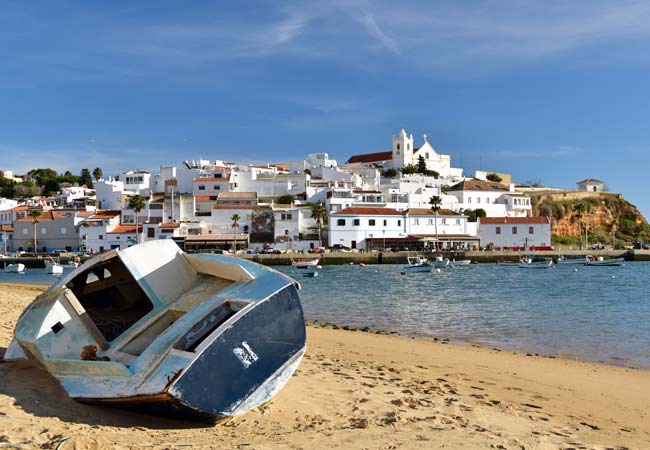
The traditional side of the Algarve
The Algarve for slow travel
The Algarve is the southernmost region of Portugal, a narrow strip of land that stretches 155 kilometers along the southern coastline and 50 kilometers to the interior. To the north the Algarve borders the rural Alentejo region, while to the east is the mighty Guadiana River that forms the natural border with Spain.
The majority of the population live along the coastline, which can be divided into three regions; the cliffs and sheltered beaches of the west, the wetlands of Faro and the vast beaches of the east. Most of the of the Algarve’s mass tourism is found in the centre and western regions between Portimão and Vilamoura. For slow travel this is the general area to avoid.
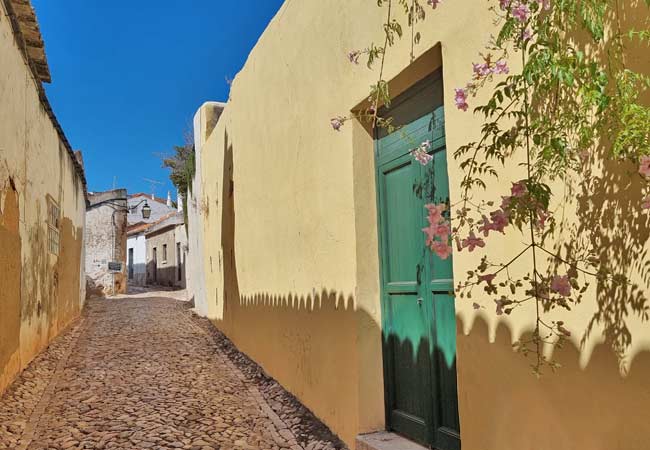
The quiet streets of Silves
The shoulder season is the best time of year for slow travel in the Algarve, either in the spring, from March through May or in the autumn, from September through to the end of October. This ensures you will avoid the high prices and overcrowded peak season of summer while missing the (possibly) wet winter months.
Note: The weather is suitable for spending time on the beach from May until the end of September.
The low and winter months (October- March) are the best season for meeting locals and long stay residents in the many cafes and restaurants.
The interactive map below shows the best towns and villages for slow travel in the Algarve and with the major resort towns.
Large towns (green): 1) Lagos 2) Praia da Rocha 3) Albufeira 4) Vilamoura
Medium towns (yellow): 1) Alvor 2) Carvoeiro 3) Armação de Pêra 4) Olhos de Água 5) Quarteira 6)Tavira 7) Monte Gordo
Villages (blue): 1) Praia da Luz 2) Porto de Mós 3) Ferragudo 4) Galé 5) Cabanas
A slow travel tour of the Algarve
The appeal of the slow travel is to discover your own special places and unique experiences, but with the whole of the Algarve to explore it can be difficult to establish what towns and regions to include or avoid. This complexity of planning is also compounded by promotion of the major tourists destinations, either for family holidays or mass tourism.
The best areas for slow travel are the east Algarve, the interior and the far west (west of Lagos). These area have been least influenced by tourism and retain their distinctive Portuguese character.
The following section details a suggested slow travel tour of the Algarve.
Insight: This following route is designed for visitors who are either new to the Algarve or the concept of slow travel. If you are seeking a more authentic and nature focused route (and you have camper van or car), we would suggest traveling along the western Alentejo coastline from Sagres up to Port Covo, taking in Villa Nova de Milfontes.
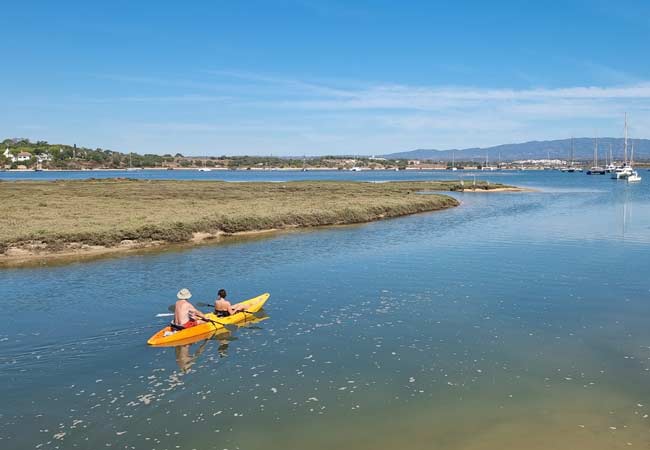
It is easy to escape the masses of summer tourist in the Algarve; such as in the calm waterways of the Ria Alvor
A suggested slow travel route of the Algarve.
To begin your holiday, it is suggested that you base yourself in Faro for at least the first few days.
Faro maybe the nearest city to the main international airport of southern Portugal, but it has an authentical Portuguese atmosphere and a delightful historic centre. Here you can stroll around the tiled plazas of Faro’s old town, pop into a café for a coffee and one of the famous custard tarts called, pastel de nata, or sample a delectable glass of local wine for just a few euros per glass.
Nearby the Rio Formosa lagoon, named one of the Seven Natural Wonders of Portugal, is a haven for migratory birds, endangered species like the chameleon and seahorse and the friendliest one of all, the Portuguese water dog.
As a day trip from Faro you could visit the delightful village of Estoi, with its grand Rococo palace and Roman ruins. An alternative are the pristine beaches of the Ilha Deserta (Deserted island) or the car free fishing village of Culatra.
While in faro remember that this is slow travel, so there is no need to hurry. Relax, shake off your stress, worries or jet lag and embrace all that the Algarve has to offer.
Related articles: Faro guide – A one day tour of faro
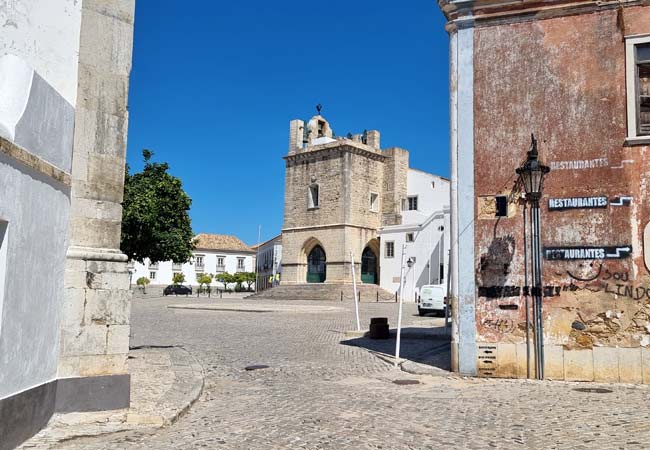
The historic centre of Faro
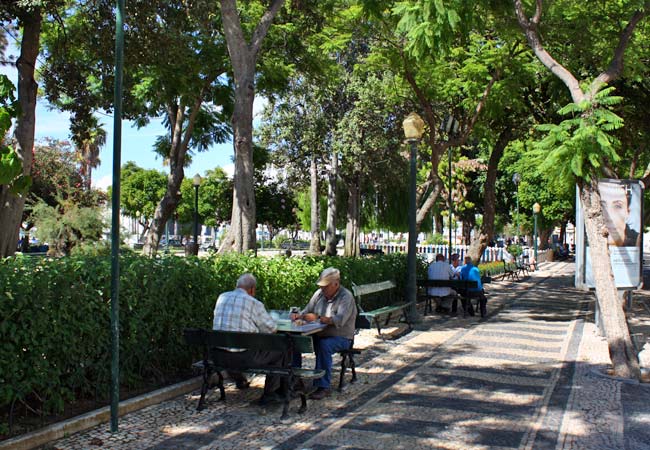
The Jardim Manuel Bívar in Faro
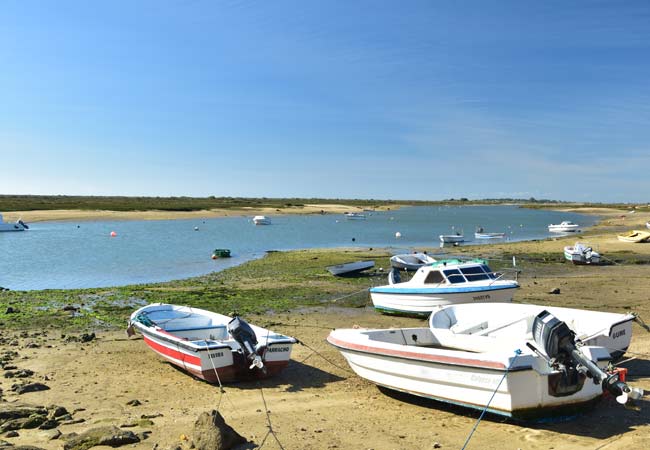
The Rio Formosa nature park
The second suggested destination is Tavira, a 45min train (or 25-minute drive) east from Faro. Situated about 30-minutes from the Spanish border the charming town of Tavira is a favorite among many. Meander along the labyrinth of cobbled lanes and admire the historic homes still covered with traditional Portuguese tiles called, azulejos.
The slow moving Gilão River runs through the center of town and is lined with shops and restaurants where you will commonly hear Portuguese spoken. A ruined castle has been transformed into a garden within its outer walls that can still be accessed by steps for a bird’s eye view of the old town. Just south of the town Tavira Island is home to a stretch of soft, sand beach that can be easily accessed by a ferry that runs year-round.
Related articles: Tavira guide
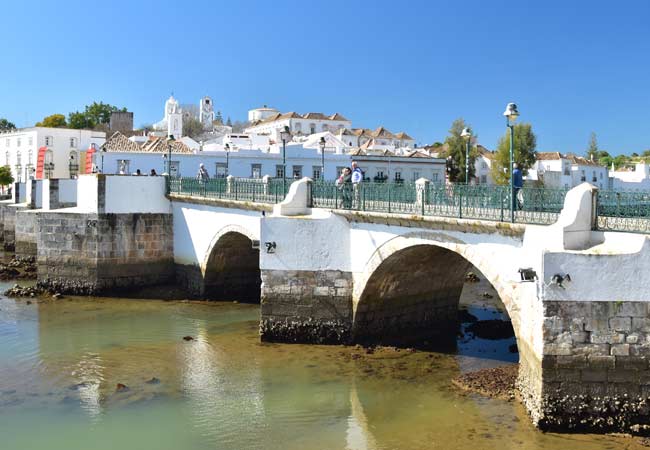
The Roman bridge in Tavira
The next destination is Loulé, a traditional Portuguese market own that is situated inland. Within Loulé is an attractive, Arabic inspired marketplace dominates the old-town and is worth a visit just to see the building alone. Filled with a fragrant array of fresh produce, meats, handicrafts and more the market is open every day. On Saturdays the market spills out into the streets and a lively gypsy market is held nearby. Loulé is a traditional working-class town that has more of a local vibe.
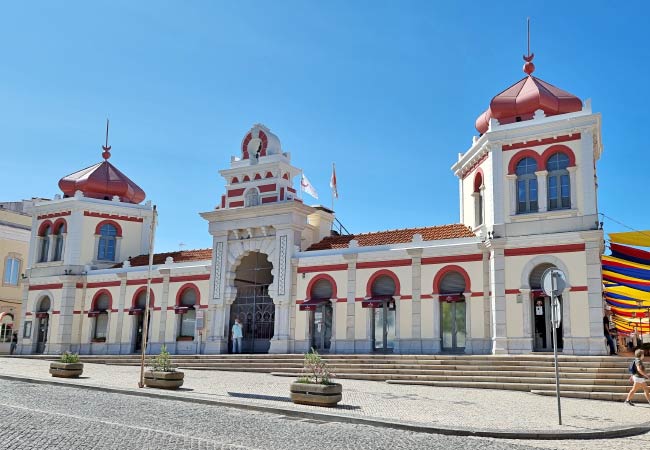
The covered market building of Loulé
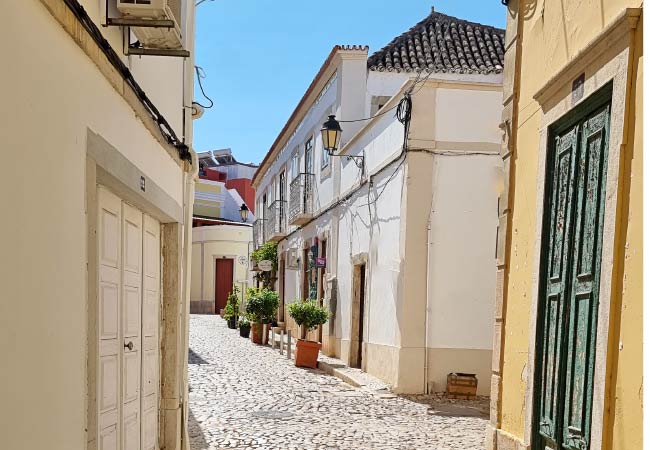
The cobbled backstreets of Loulé - are ideal for slow travel
Further west by 20-minutes (17km) your next stop will transport you from local charm to the refined elegance of Vilamoura. A resort town built around six golf courses, a large marina complex, a casino that hosts nightly shows, an equestrian center and gorgeous beaches. Although Vilamoura does fill with tourists during the summer they tend to be Portuguese families from up north instead of the wild party crowd that frequents the nearby city of Albufeira. Hiking trails run along the top of Falesia beach and offer majestic views of the coastline, and ochre-colored cliffs. Falesia in Portuguese means cliffs, so the beach is aptly named for its most prominent feature.
Back on the road let’s head west 40-minutes (50km) to the coastal haven of Carvoeiro. Here wooden boardwalks lead to clifftop walks of the Algar Seco, a stunning stretch of coastline with craggy rock formations, soaring cliffs and caves. Carvoeiro is a typical beach town with souvenir shops and restaurants offering the freshest catch of the day.
A short 13-minute drive from the Algar Seco will take you to another favorite spot called Praia da Marinha. Considered to be one of the most beautiful beaches in Portugal, follow along the scenic paths that open to more coastal wonders of heart shaped rocks, sapphire water, and golden coastline. The tiny village of Porches is well known for artisans selling handmade pottery and ceramics, just a ten-minute drive from the coast.
Drive another 38-minutes west (42km) to the popular town of Lagos. The charming old town was once protected by a 17th century fort that now houses a small museum and traditional draw bridge. Boats can be hired from here for adrenaline filled rides through caves, grottoes, and stunning coastline. Surf shops line the promenade and the beach is just steps away from the town center.
Prepare to be wowed when you set eyes on the area of Ponta da Piedade, just a short drive from the town center. A series of easy to navigate boardwalks and steps overlook the jaw dropping coastline dominated by towering cliffs, rocky formations, and clear, azure water.
Feel as if you are standing on the edge of the earth in the remote village of Sagres, a 36-minute drive (31 kilometer) from Lagos. The barren landscape, ranging sea and towering cliffs will leave you breathless. Nearby, the Cabo de São Vicente headland will have you perched at the southwestern most point of Europe. Adventure seekers come here to challenge the sea, hike along the cliffs or cycle in the windy wilderness, while others are happy to just breathe it all in.
Slow travel is just that, meant to be slow, relaxed and calm. Drive down back roads, get lost in every hidden sea cave, sink your toes in the sand and plunge into the depths of life that surround you in this marvelous wonder called Portugal.
A suggested slow travel route of the Algarve
The best way to explore the Algarve is to fly directly into Faro International Airport which is situated almost directly in the middle of the region. Pre-arrange to hire a car to make the most of your time in the Algarve. Do keep in mind that most cars in Portugal are equipped with a standard transmission, so if you are not comfortable driving a car with a clutch be sure to ask for an automatic long before your visit. Also, make sure that your rental car has a transponder that will automatically keep a running tab on tolls.
Passport holders from many countries can enter Portugal on simply a tourist visa and stay for up to 90 days, but prior to your visit do make sure this applies to your type of passport.






















